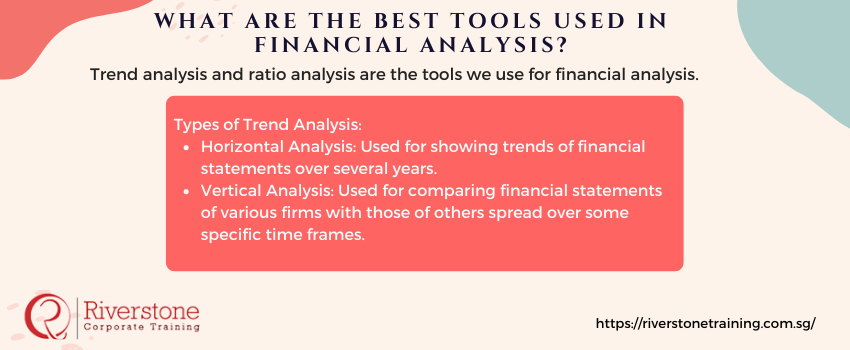
Best Tools Used in Financial Analysis
Trend analysis and ratio analysis are the tools we use for financial analysis. The former is used for interpreting techniques used in the establishment of patterns in the financial statement. The latter, on the other hand, offers insight into the elements of financial statements and how these elements relate to each other. We use the financial analysis to assist us in carrying out analyze of a given firm.
Examples of the Best Tools Used in Financial Analysis and Planning
They are mainly three such examples here and include the preparation of comparative financial statements, common-size statements, and trends or percentages.
- The comparative income statement shows the relationship between sales and cost of goods sold.
- For the common size statements, each statement reduced to a total of 100% before being expressed as a percentage of the whole.
- Finally, on-trend percentages, we compare past data covering a given period and one base year.
Types of Trend Analysis as the Best Tools Used in Financial Analysis
There are two main types, i, e the vertical and horizontal analysis.
- The horizontal analysis is used for showing trends of financial statements over several years. This analysis builds projection models for forecasting future financial performance. Secondly, you would need this analysis is used for identifying problem areas by looking for any abnormal changes in financial statements.
- On the other hand, the vertical analysis is used for comparing financial statements of various firms with those of others spread over some specific time frames. In the vertical, we take total assets in the balance sheet and total sales in the income statement as the base number (100%)
Size can be a problem in the vertical analysis and therefore, must be removed in the ratio analysis. The idea is to use common –size situation in the financial statements. The reason for the choice of the common size of the common –size financial statements is that it is used. It is restated as a percentage.
Practical Application of Financial Analysis Tools in Singaporean Businesses: Case Studies
Did you ever want to know how Singaporean businesses really run using financial analysis to prosper? Suppose we get a glimpse of a situation: vibrant local chain of Cafes, missing body. Imagine, Kopi King. After conducting ratio analysis namely focusing on their gross profit margin and operating expenses, they found out that increase in cost of ingredients and ineffective scheduling of staff were the villain. Equally, Lion City Logistics, which is a transport company, trend analyzed their quarterly income. This brought to the fore a continuous decline in revenue during the public holidays, thus forcing them to introduce special holiday packages to contain the revenue. Such practical examples demonstrate that financial analysis is not a theory, rather, it is an ultimate guide that may serve local business as it makes its way through the Singapore marketable environment. To truly harness the power of these insights for your own business, consider deepening your expertise through a comprehensive course for Professional business valuation training Singapore—an essential step for anyone serious about strategic growth and informed decision-making in Singapore.
Beyond Ratios and Trends: Integrating Advanced Financial Analysis Tools for the Singapore Market
Although ratio and trend analysis remain a staple, the Singaporean business environment of the 21 st century can take its analysis to the next level by leveraging the capabilities of the most advanced tools. Consider the capabilities of cloud-based accounting systems, such as Xero or QuickBooks, that have automated data entry and they offer up to date dashboards so that finance can be checked on the fly. When you need to go deeper, think about business intelligence (BI) tools that have the potential to combine the data of many sources, including sales, market, and operations, to reveal hidden relationships and forecast performance. Simply basic spreadsheet functions having advanced formulas are capable of empowering SMEs to develop great financial models. Accepting such technological innovations would imply going beyond numbers to strategic vision within the Singapore market competencies. To apply these financial analysis tools effectively in real-world scenarios, consider enrolling in a financial modeling course Singapore for professionals — a practical, hands-on program designed to boost your analytical and strategic skill set.
Mastering Financial Analysis for Startups and SMEs in Singapore: A Step-by-Step Guide
To Singapore start-up and SME ecosystems, financial analysis may appear to be the devil, but it is so within reach. Begin with an open attitude towards decent bookkeeping much lesser applications cost nothing, such as Wave Accounting. Then, devote your attention to two important reports: your Profit & Loss Statement (to check whether or not you are making money) and your Balance Sheet (to know what you have in terms of assets and liabilities). Then, select some key to ratios, such as current ratio so you can monitor that you are not in danger in liquidity or debt to equity so you can determine your risk. Reviewing such simple measures may help avoid the cash flow crisis and bring sensible growth. It involves acquiring good habits and making informed decisions based on simple analysis to suit your growing venture in Singapore. If you’re ready to deepen your understanding and take your financial skills to the next level, explore The Ultimate Guide to Choosing the Best Finance Course in Singapore.

